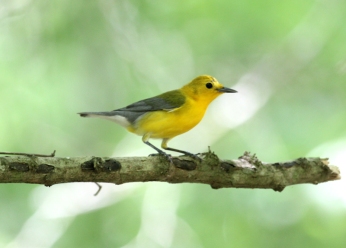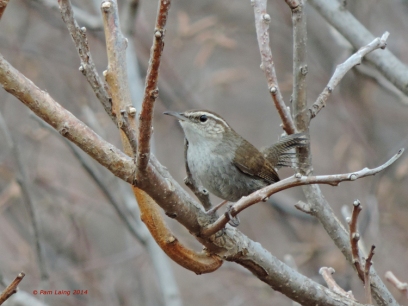Our second full day of birding on the Upper Texas Coast began cloudy, warm and humid. We left our hotel near the Houston Airport at 7 AM and drove to Winnie, which took about 1.5 hours. We then made our way towards the world-famous Anahuac National Wildlife Refuge, though it took us a long time to get there due to several excellent flooded rice fields along the access road to the refuge. Shorebird numbers were pretty staggering. There were hundreds of Whimbrel, Willets and Lesser Yellowlegs wading in the fields. Mixed in were more goodies like American Golden Plover, Stilt Sandpiper, Upland Sandpiper, Long-billed Dowitchers, and Black-necked Stilts to name a few. Several Scissor-tailed Flycatchers were crowd pleasers as they sallied out for insects from powerlines along the road. Loggerhead Shrike, Swainson’s Hawk and our first Eastern Kingbirds were added to the trip tally.

At Skillern Tract we were treated to a real ‘rail show’ when a very obliging King Rail wandered out in front of us, followed by a Virginia Rail and a Sora! The wetland here also produced Purple and Common gallinules, Black-crowned Night-Herons and Black-bellied Whistling-Ducks. One of my ‘crew’ photographed a gorgeous Yellow-bellied Water Snake as it crossed the path in front of him. The rest of us missed seeing the snake, but we were happy enough to see an American Alligator swimming across a waterway.

We made our way to the Anahuac NWR visitor center and we just arrived in time. The clouds rolled in, dark and gray, and thunder could be heard in the distance. We took refuge in the bran spanking new center while the rain just chucked down outside for an hour or so. When we braved the elements and went outdoors the temperature had dropped an astonishing 10 degrees celsius over the course of the hour and a howling north wind made it feel even colder. The rest of the afternoon was spent birding from inside the van as we drove around Shoveler Pond at Anahuac. Through the water covered windows we could make out Roseate Spoonbills, White-faced Ibis, Neotropic Cormorants, Tricolored Heron, Forster’s and Caspian terns, and Fulvous Whistling-Ducks, amongst others. A Least Bittern flew by the van at eye level which was a welcome surprise.

When an April cold front blows across the Texas Coast the birders begin to twitch and shuffle with excitement of the possibility of a fallout. We will keep our fingers crossed that tomorrow will produce some epic birdwatching at High Island!
April 15 – Alas, the cold front did not produce a mega fallout today. Apparently, the cold front extended into southern Mexico and basically no birds lifted off from the Yucatan yesterday. That said, we still had a good day. When we emerged from our hotel the temperature was a bone chilling 3 degrees celsius! The wind blew for most of the day from the north, making it quite a chilly experience. At High Island’s Boy Scout Woods we started off with a bang, a male Golden-winged Warbler flitted about right near the park entrance. Along the trails we picked up other migrants such as a stunning male Hooded Warbler, some Tennessee Warblers, a Blue-winged Warbler and Northern Parula. Non-warbler migrants included Baltimore and Orchard orioles, Swainson’s Thrush, Brown Thrasher and Indigo Bunting.
Next, we moved on to the Bolivar Peninsula. The wind hampered with us here too, not allowing us to use our scopes. The strong wind basically blew all the water from Rollover Pass off into the bay, and simulated a mega-low tide, making the birds way too far away to see. Still, we picked up some shorebirds at Rollover, such as Marbled Godwit, Ruddy Turnstone, Semipalmated Plover, Short-billed Dowitcher and Sanderling. Several tern species, including Royal, Least, Forster’s and Sandwich sailed by, as did Brown Pelicans and Laughing Gulls.

Along Yacht Basin Rd we had several very confiding Long-billed Curlews in amongst the marsh. A distant Wilson’s Plover was seen through the shaky scope, and a Least Sandpiper paused briefly. Best bird here though was a Clapper Rail wandering around in a watery channel about 15 feet in front of us….and where was my camera? In the van.
After a coffee stop to warm ourselves up, we carried on to Bolivar Flats. Most of the birding had to be done from inside the van here, because otherwise we would have been ‘sandblasted’. We did get out however, to put a lovely Piping Plover in the scope. Also along the Bolivar Peninsula today we had Crested Caracara and Peregrine Falcon.
To finish off the day we spent a couple of lovely hours at High Island’s Smith Oaks, where the breeze died down a bit and we found ourselves shedding layers. The birds were quite good here, with the highlight being a gorgeous male Painted Bunting feeding on some mulberries. A dozen or so Rose-breasted Grosbeaks paid the mulberries a visit as well, and we had great views of a couple of Yellow-billed Cuckoos. Wood Thrush sang from the understory but remained hidden, and although we could hear warblers chipping away in the trees, the only new one we saw was a female Black-and-white Warbler. Since the passerine migration was a bit slow, I took the group to the heronry, which is always a big hit, especially with any photographers in the group. We watched, at close range, nesting Great and Snowy egrets, Tricolored Herons, Roseate Spoonbills and Neotropic Cormorants. Even though there was no fallout, we had a great day of birding.

Chris Charlesworth








